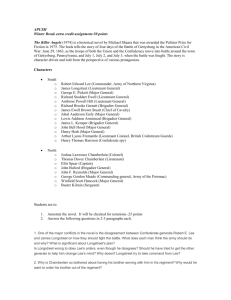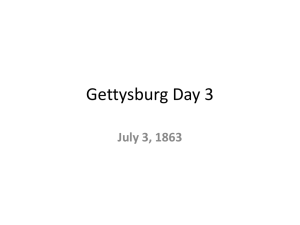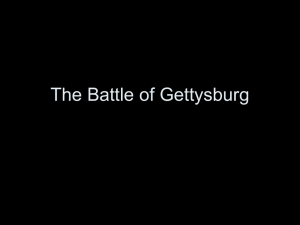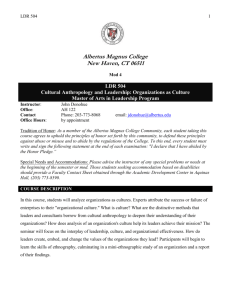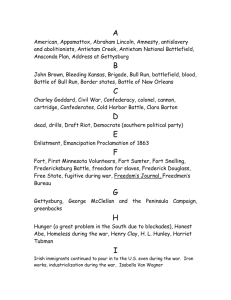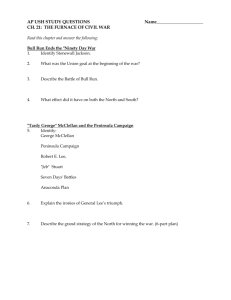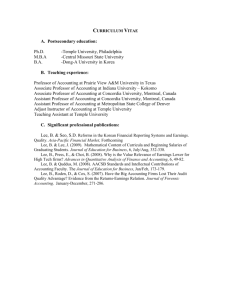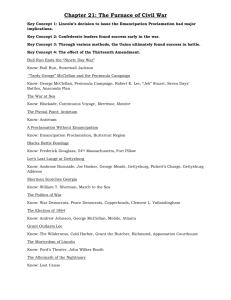Critical Book Review of Michael Shaara's Civil War Novel The Killer
advertisement
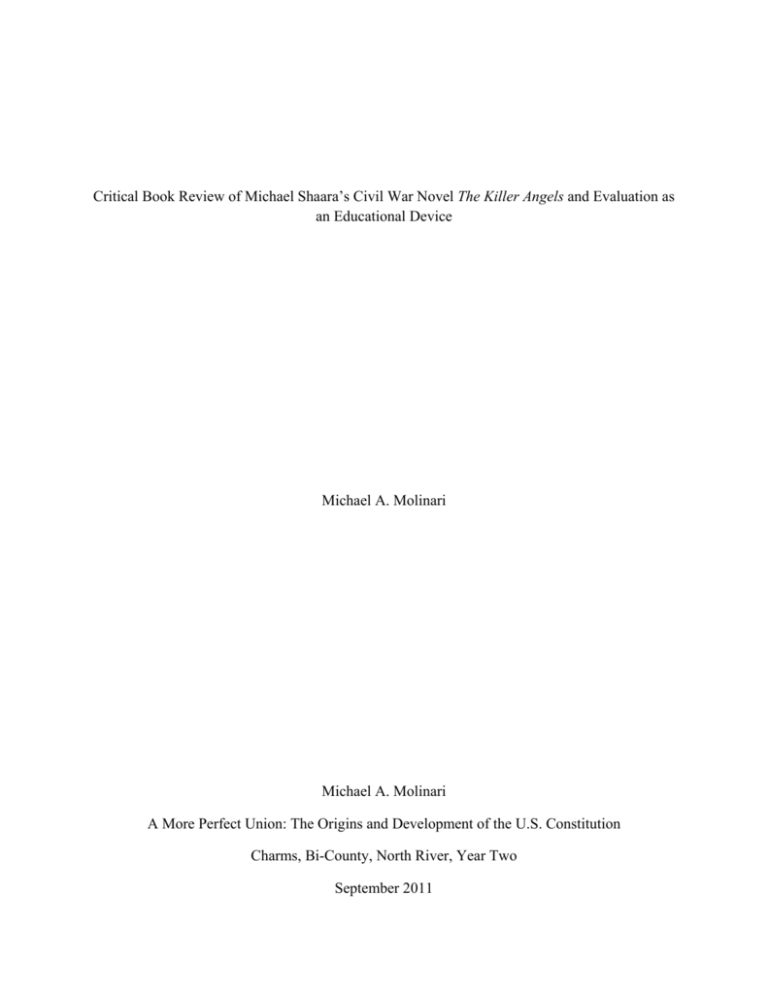
Critical Book Review of Michael Shaara’s Civil War Novel The Killer Angels and Evaluation as an Educational Device Michael A. Molinari Michael A. Molinari A More Perfect Union: The Origins and Development of the U.S. Constitution Charms, Bi-County, North River, Year Two September 2011 2 Michael Shaara’s Pulitzer Prize winning historical novel The Killer Angels has been hailed by Civil War historians such as James McPherson as, “a superb recreation of the battle of Gettysburg” for providing insight into what the “war was about, and what it meant.” This endorsement summarizes the reasons Shaara’s novel could be added to secondary school history curricula, especially curricula intended to impart knowledge about the American Civil War. Scholars generally shy away from novels when attempting to study and analyze historical events. Novels do not contain footnotes, endnotes or lengthy bibliographical essays. For these reasons historians fear the information contained within historical novels may include biases or facts that cannot be substantiated. Shaara, a science fiction novelist turned historical novelist, includes a note to the reader prior to his foreword explaining how he approached his work, perhaps to put historians’ minds at ease. Shaara states, “this is the story of the Battle of Gettysburg, told from the viewpoints of Robert E. Lee and James Longstreet and some of the other men who fought there.” He continues, “There have been many versions of that battle and that war. I have therefore avoided historical opinions and gone back primarily to the words of the men themselves, their letters and other documents. I have not consciously changed any fact.”1 Shaara’s note to the reader and the fact that he spent seven years researching and revising the book following a family vacation to Gettysburg proves the motivation Shaara had to write a fact based historical novel worthy of praise. Despite its critics, Shaara’s novel won a Pulitzer Prize and was the inspiration for Ronald F. Maxwell’s film adaptation, Gettysburg; both are currently used in classrooms across the world. 1 Shaara, Michael. The Killer Angels. (New York: Random House Publishing Group, 2003), xiii. 3 Shaara’s foreword is a valuable teaching tool which contains brief biographies of the armies and men who fought at Gettysburg. He provides an overview of the armies’ conditions prior to their collision at the then little know town of Gettysburg. Shaara analyzes the Army of Northern Virginia under the generalship of Robert E. Lee by exclaiming, “They are rebels and volunteers. They are mostly unpaid and usually self-equipped. This is an army of remarkable unity, fighting for disunion. It is Anglo-Saxon and Protestant. Though there are many men who cannot read or write, they all speak English. They share common customs and a common faith and they have been consistently victorious against superior numbers.”2 Shaara masterfully summarized the character of the Army of Northern Virginia and its inherent hypocrisy. An army “remarkably” unified by race and religion fighting “remarkably” for disunion. Shaara’s assessment of the Army of the Potomac is equally masterful as he juxtaposed them with the Army of Northern Virginia. Shaara wrote, “It is a strange new kind of army, a polyglot mass of vastly dissimilar men, fighting for union. There are strange accents and strange religions and many who do not speak English at all. Nothing like this army has been seen upon the planet. It is a collection of men from many different places who have seen much defeat and many different commanders.”3 Shaara’s juxtaposition and analysis of the Army of Northern Virginia and the Army of the Potomac is an excellent summary of these two armies. Teachers may highlight the differences between the North and the South based on these quotes alone. One may ask why the Army of Northern Virginia was united as an Anglo-Saxon, English speaking force, determined to preserve its way of life, while also entertaining why the Army of the 2 Shaara. The Killer Angels, xv. 3 Ibid., xv-xvi. 4 Potomac was so diverse in its ethnicity, language, and religious traditions. Hopefully these descriptions provide a springboard from which a larger discussion can be had over the differences between the industrial urban North and the agricultural South. Shaara’s forward contains useful biographies of the commanding officers who fought at Gettysburg. These biographies are short and succinct making them useful in the classroom. The bios contain pertinent information including basic background information, whether the soldier fought for the Union or the Confederacy, military rank, and interesting anecdotes. Some anecdotal information includes Robert E. Lee’s battle with heart disease, James Longstreet’s belief in defensive warfare, and Joshua Lawrence Chamberlain’s background as a professor of rhetoric at Bowdoin College. Shaara also includes the biographies of generals who he believed helped shaped the ultimate outcome of the battle such as John Buford, for choosing to defend “good ground,” and J.E.B. Stuart, who failed to provide Robert E. Lee with information about the Union’s positions around Gettysburg. As useful as the biographies are, one of the most debatable statements in the novel is located in the foreword as a part of Lee’s biography. Shaara could be accused of participating in the deification of Robert E. Lee by downplaying his role in supporting the South’s peculiar institution. Shaara claims, “He does not own slaves nor believe in slavery, but does not believe the Negro, ‘in the present stage of his development,’ can be considered the equal of the white man.”4 Shaara’s attempt to sanitize Robert E. Lee and distance him from the evils of slavery is not unique. Some professional historians make the same claim. According to the Arlington House and Robert E. Lee Memorial run by the National Park Service, Lee did in fact manage 4 Ibid., xvi. 5 slaves on his wife’s plantation at Arlington. Lee became the executor of his wife’s estate after his father in-law George Washington Parke Custis died. According to the Arlington House website, Lee “became the effective master of Arlington after 1857. Between 1857-1861, he attempted to organize the slaves into a more efficient labor force, cleaned up the grounds, hired a new overseer and supervised the planting of crops.”5 Though one could argue Lee did not technically own any slaves prior to 1857, he certainly did from 1857 until 1861, and was considered “a more stringent taskmaster than his predecessor,” George Washington Custis, who ordered in his will that all his slaves be freed upon his death or when the estate was financially in “good standing.”6 If the estate was never to reach this “good standing,” the slaves were to be freed five years after Custis’ death regardless of the estate’s financial status. Not only did Lee stringently manage slaves as executor of the estate but he freed them only when legally forced to do so by the terms of George Washington Custis’ will in 1863. Claiming that Lee did not own slaves white-washes Lee’s immediate family’s involvement and profit off of slave labor, labor that was a prerequisite for the Lee family’s social status in Virginia and a springboard for Lee’s own success. Shaara’s statements about Lee’s disavowal of slavery allowed critics to claim Shaara downplayed slavery’s role in the outbreak of the Civil War. Film critic Gary W. Gallagher has criticized some scenes in the film Gettysburg for perpetuating the “Lost Cause Tradition.” Gallagher defines the “Lost Cause Tradition” as an exConfederate interpretive tradition that portrays the Confederate cause as, “an admirable struggle 5 Arlington House and Robert E. Lee Memorial, National Park Service. Last modified August 21, 2007. http://www.nps.gov/arho/historyculture/robert-lee.htm. 6 Arlington House and Robert E. Lee Memorial, National Park Service. 6 against hopeless odds” which “denied the importance of slavery in bringing secession and war”7 While some aspects of the book, The Killer Angels, and the film, Gettysburg, may perpetuate the “Lost Cause Tradition,” the book’s overall message is not one that is overly sympathetic to the Confederacy. For this reason the novel and film succeed in presenting a relatively unbiased version of the battle of Gettysburg despite the claim that Lee was above owning slaves. Shaara’s novel is divided into four parts accompanied by many maps of important events that took place at Gettysburg. The four parts are titled after days the battle of Gettysburg took place between Monday, June 29, 1863, and Friday, July 3, 1863. The four parts are further subdivided according to the commanding officers who played major roles on each specific day. Here, Shaara analyzes the unsung heroes of the battle of Gettysburg which are worthy of study in contemporary classrooms. Key events and decisions are covered in great detail including Major General John Buford’s decision to dismount his cavalry and defend the town of Gettysburg on July, 1, 1863, while waiting for John Reynolds’ infantry division for reinforcement. Reynolds is killed and Buford dies later due to the injuries he suffered that day. According to Shaara, Buford never received “recognition for choosing the ground and holding it” and that in doing so he possibly saved “not only the battle but perhaps the war.”8 Buford’s decision prevented the Confederates from seizing the high ground overlooking the town of Gettysburg, high ground that played a pivotal role on July, 3, 1863, when Union artillery decimated Pickett’s charge. Shaara’s acknowledgement of unsung heroes such as Buford is a welcome addition to his novel and another great aspect to use in the classroom. 7 Gallagher, Gary. “Causes Won, Lost, and Forgotten: Hollywood and the Civil War since Glory” (Perspectives on History, May 2008), 24. 8 Shaara. The Killer Angels, 354. 7 Shaara also does an excellent job revealing the errors Robert E. Lee and other Confederate generals made at Gettysburg, proving that Lee was not the invincible demi-god he is still recognized as in certain historical circles. For this reason it is tough to argue that his book promotes the “Lost Cause Tradition.” Due to Buford’s noteworthy defense, by the evening of July, 1, 1863, the Union defenses were not only reinforced but very strong. Prior to this reinforcement Lee ordered Richard Ewell to attack Cemetery Hill, “if practicable.” James McPherson, author of Battle Cry of Freedom, argued that Ewell’s failure to take the high ground created one of the “controversial “ifs” of Gettysburg that have echoed down the years.”9 There are many “ifs” of Gettysburg usually designed to shield Robert E. Lee from any fault in losing the battle. Along with Ewell’s failure, Cavalry General J.E.B. Stuart’s failure to report Union positions is often cited as a blunder to deflect blame on Lee for losing the battle. Even Longstreet, Lee’s second in command, will not be free from blame by war’s end. Even though many people defend Lee today, Shaara does not shy away from exposing Lee’s tactical blunders halting the deification process in its tracks. In The Killer Angels, Shaara does an excellent job of analyzing the tactical debates between James Longstreet and Robert E. Lee. Throughout the novel Longstreet warned Lee that attacks upon the Union’s entrenched hill-top positions would be folly. Longstreet preferred fighting a defensive war and hoped to retreat into a better position, possibly cutting off the Union army from Washington. Lee’s counter argument in Shaara’s novel was that a retreat would ruin morale. The arguments between Longstreet and Lee are substantiated by James McPherson who 9 654-655. McPherson, James. Battle Cry of Freedom: The Civil War Era (Oxford: Oxford University Press, 1988), 8 wrote, “studying the Union defenses through his field glasses on the evening of July 1 [sic] and again the next morning, Longstreet concluded that this line was too strong for an attack to succeed. He urged Lee to turn its south flank to get between the Union army and Washington. This would compel Meade to attack the Army of Northern Virginia in its chosen position. Longstreet liked best the tactical defense.”10 The overly aggressive Lee believed, “the morale of his veteran troops had never been higher; they would regard such a maneuver as Longstreet suggested as a retreat” and “lose their fighting edge.”11 Another character showcased in Shaara’s book is the British observer of Gettysburg, Arthur Fremantle. Fremantle’s diary recorded the debate between Longstreet and Lee. According to the diary, Lee stated, “the enemy is there, I am going to attack him there,” to which Longstreet replied, “If he is there, it will be because he is anxious that we should attack him; a good reason, in my judgment, for not doing so.”12 Conversations within Shaara’s novel show careful consideration of primary source material, such as The Fremantle Diary, allowing scholars to feel comfortable with the novel’s level of historical accuracy, again proving the novel’s value as an educational device. Other pertinent conversations within the novel that debunk the “Lost Cause Tradition” include Longstreet and Lee discussing slavery as a cause of the Civil War and their anguish over breaking their officer oaths. The West Point officer oath that Confederate officers broke is as follows: 10 McPherson. Battle Cry of Freedom, 655. 11 Ibid., 655. 12 Ibid., 656. 9 I, _________________, do solemnly swear or affirm (as the case may be) to bear true allegiance to the United States of America, and to serve them honestly and faithfully, against all their enemies or opposers whatsoever, and to observe and obey the orders of the President of the United States of America and the orders of the officers appointed over me.13 The harshest critics of the Confederacy claim that Robert E. Lee and other officers were traitors for breaking this Army oath. Though Lee was promised amnesty by Grant he was never pardoned during his lifetime despite those who continue to glorify his gallantry in fighting for “The Lost Cause.” To be fair, Shaara claimed Lee’s “prestige brings a peace which might not have been possible.”14 Not only did Lee’s prestige bring peace which might not have been possible, but his tactical decisions at Gettysburg accelerated the peace process by paving the way for a Union victory. Although the book is written from the viewpoint of Lee and Longstreet several portions of the novel are devoted to Northern heroes such as the previously mentioned Buford and Joshua Chamberlain, colonel of the 20th Maine, famous for their bayonet charge on July, 2, which prevented the Confederate forces from outflanking Union defenses. Shaara takes his time to introduce and develop Chamberlain’s character, paying close attention to the reasons why the North was waging the war. Shaara summarizes Chamberlain’s beliefs for waging the war by stating: This was the first place on earth where the man mattered more than the state. True freedom had begun here and it would spread eventually over all the earth. But it had begun here. The fact of slavery upon this incredibly beautiful new clean earth was 13 Coffman, Edward. “The Army Officer and the Constitution” (U.S. Army War College: Carlisle, PA, 1987), 4. 14 Shaara. The Killer Angels, 354. 10 appalling, but even more than that was the horror of old Europe, the curse of nobility, which the South was transplanting to new soil. They were forming a new aristocracy, a new breed of glittering men, and Chamberlain had come to crush it.15 Statements such as this disprove Shaara’s critics who claim he is overly sympathetic to the Southern cause. Shaara does not shy away from citing slavery as the war’s main cause and glorifying men like Chamberlain who believed they were fighting a just war to emancipate millions of slaves in the South. Interestingly, Chamberlain’s success on Little Round Top on July, 2, resulted in the 20th Maine being relocated to the center of the Union line. Ironically, the center of the Union line was believed to be the safest place on the battle field until Lee ordered his most daring and controversial assault of the entire war, Pickett’s charge on July, 3, 1863. Lee’s final attempt to drive the Union off the high ground at Gettysburg resulted in a miserable failure for the Confederacy and was predicted by James Longstreet. In Shaara’s novel, Longstreet’s predicts his army’s fate providing an excellent account of what took place: He could begin to see it. When the troops came out of the woods the artillery would open up. Long-range artillery, percussion and solid shot, every gun on the hill. The guns to the right, on Rocky Hill, would enfilade the line. The troops would be under fire with more than a mile to walk. And so they would go. A few hundred yards out, still in the open field, they would come within the range of skirmish, aimed rifles. Losses would steadily increase. When they reached the road, they would slow by the fence there, the formation, if it still held, would begin to come apart. Then they would be within range of rifles on the crest. When they crossed the road, they would begin to take canister fire and thousands of balls of shrapnel wiping huge holes in the lines. As they got closer there would be double canister. If they reached the wall without 15 Ibid., 27. 11 breaking there would not be many of them left. It was a mathematical equation.16 According to Longstreet’s actual words he knew the futility of the attack. Longstreet wrote, “I could see the desperate and hopeless nature of the charge” and that “there was never a body of fifteen thousand men who could make that attack successfully.”17 The futility of the attack and Longstreet’s protests to Lee did not stop Pickett’s charge from occurring. Robert E. Lee accepted the blame for the defeat and lamented, “it’s all my fault,” and proceeded to order his men to rally by stating, “it is I who have lost this fight, and you must help me out the best of it the best way you can.”18 Amazingly, Lee’s men rallied, many men still believing in the invincibility of their General and their cause, escaping the field the next day allowing the Confederacy to survive for another two years. Despite what many confederate soldiers wanted to believe, the fact remained that Lee’s invincibility was broken at Gettysburg and Shaara’s careful recreation of the battle including Lee’s tactical miscalculations help reveal this fact. Sections from Shaara’s novel, such as Longstreet’s prediction, could be used in the classroom to illustrate the nature of the battle’s final day. By using portions of the book in conjunction with scenes from the film Gettysburg an educator has endless opportunities to share the importance of the battle and the major characters that participated in it. I would not recommend showing the entire film as it is two hundred and fifty-four minutes long (over four hours) and contains some lengthy scenes devoted to the complexities of the causes of the war and/or character development, which only highly motivated honors 16 Ibid., 299. 17 McPherson. Battle Cry of Freedom, 661. 18 Ibid., 663. 12 students may be able to grasp. The scenes I would recommend showing would be John Buford’s defense of Gettysburg on July, 1, Josh Chamberlain’s defense of the Union flank on Little Round Top on July, 2, and Longstreet and Lee’s debates over Pickett’s charge and the ensuing massacre that occurred on July, 3. These scenes are the most action packed and provide great insights into why the Union won the battle despite the supposed invincibility of Robert E. Lee and the gallantry of Confederate soldiers. 13 Bibliography Arlington House and Robert E. Lee Memorial, National Park Service. Last modified August 21, 2007. http://www.nps.gov/arho/historyculture/robert-lee.htm. Coffman, Edward. “The Army Officer and the Constitution” U.S. Army War College: Carlisle, PA, 1987. Gallagher, Gary. “Causes Won, Lost, and Forgotten: Hollywood and the Civil War since Glory” Perspectives on History, (May 2008): 24-25. Gettysburg, directed by Ronald F. Maxwell. 1993; Burbank, CA: Warner Bros Home Video, 2006. DVD. McPherson, James. Battle Cry of Freedom: The Civil War Era. Oxford: Oxford University Press, 1988. Shaara, Michael. The Killer Angels. New York: Random House Publishing Group, 2003.
